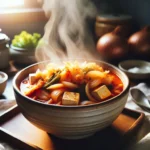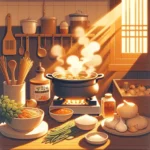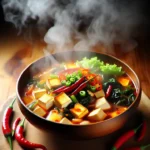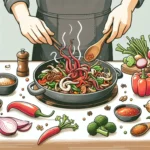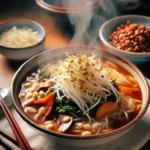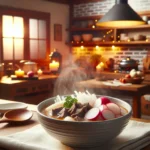Imagine a steaming pot of rich, savory broth, bubbling with an array of vibrant ingredients that tell stories of comfort and community. Budae Jjigae, often referred to as Korean Army Stew, is more than just a meal; it’s a heartwarming delight that evokes memories of shared moments and laughter. As you embark on this culinary journey, let the aroma transport you to bustling kitchens in Korea, where flavors collide to create magic. Let’s explore the key ingredients, intricate steps, and little secrets that will ensure your own version of this iconic dish captures its authentic essence. Discover the joy of serving this beloved stew, and elevate your dining experience into something truly special.
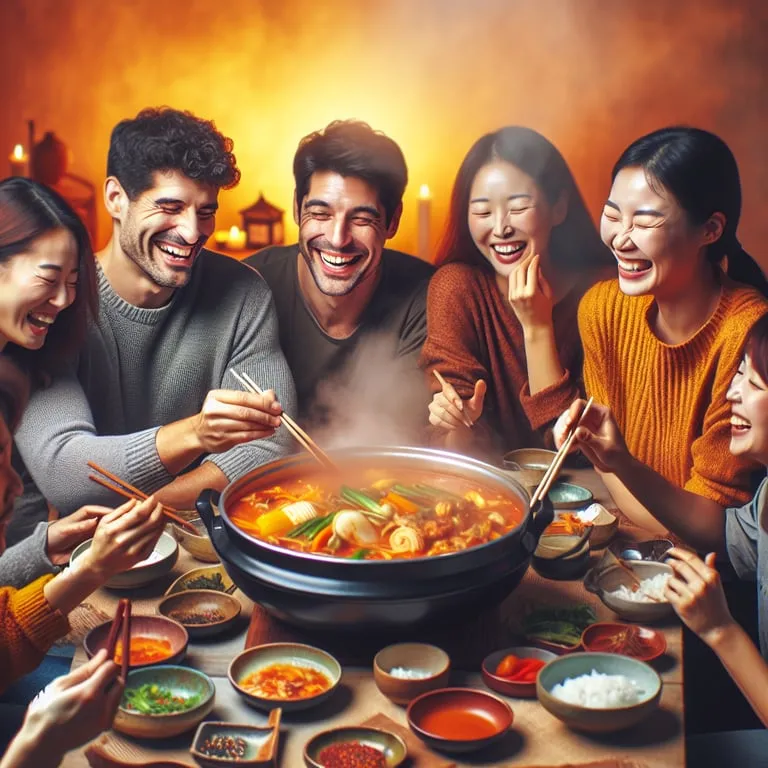
Key Ingredients for Authentic Budae Jjigae
To create an authentic Budae Jjigae that tantalizes your taste buds and warms your soul, it’s essential to select the right ingredients! This unique dish hailing from Korea combines elements of traditional stews with influences from American military rations, offering a delightful fusion of flavors. Here’s a deep dive into the key components that will elevate your stew to culinary greatness!
Essential Noodles
First and foremost, Korean ramyeon noodles are an absolute must! These chewy noodles cook up perfectly in the broth and provide a delightful texture. A standard serving typically includes around 80 to 100 grams per person, which is sure to satisfy your hunger. 🍜
Protein Choices
Next up, let’s talk about the protein source—the heart of your Budae Jjigae. A blend of ingredients is ideal for a robust stew! You can use sliced Spam or sausage—about 150 to 200 grams combined—as they bring a savory element to the dish. Pork belly can also be utilized for a richer flavor; aim for 100 grams, sliced thinly. This blend captures that authentic ‘military stew’ vibe! Who can resist the comforting goodness? 😋
Tofu and Kimchi
Don’t forget the tofu! Firm tofu, approximately 150 grams, adds creaminess and balances out the richness of the meat. It soaks up the broth’s flavors while providing a satisfying bite. Speaking of flavor, the addition of kimchi is indispensable. About 100 grams of well-fermented kimchi will introduce a spicy, tangy kick that makes the dish irresistible!
Vegetable Medley
When it comes to vegetables, a medley enhances both taste and nutrition. Onions, green onions, and shiitake mushrooms are fantastic choices. Use a medium-sized onion (dice it!) and around 50 grams of sliced shiitake mushrooms to add umami! Green onions bring freshness—add a handful, finely sliced, to boost that lovely aroma! 🌿
The Broth
Now let’s consider the broth! A rich, flavorful base is paramount! A mix of water (about 4 cups) and Korean gochujang (2 tablespoons) will do wonders. Add in some gochugaru (Korean red pepper flakes) for an extra kick—1 tablespoon should suffice if you’re feeling daring! Don’t forget the magic ingredient: soy sauce (2 tablespoons)! This combination creates a depth of flavor that will make your stew sing!
Toppings for the Finish
Lastly, toppings can elevate your dish to another level! Consider garnishing with sesame oil, fresh cilantro, or even a sprinkle of cheese to create a fusion twist that pleases the palate! Each topping can add diverse textures and flavors, making each bowl a unique experience! 🧀🌶️
Incorporating these ingredients ensures you will cook a genuine and heartwarming Budae Jjigae that pays homage to its historical roots while delighting your senses. So gather these elements, prepare your kitchen, and embark on a culinary adventure that will surely impress your friends and family! Happy cooking! 🥳
Step-by-Step Cooking Instructions
Embarking on the culinary journey of crafting the perfect Budae Jjigae is not just a cooking task; it’s an exciting adventure that tantalizes the taste buds! 😋 Here’s a detailed guide for you to master this iconic Korean army stew, ensuring that every bite packs a punch of flavor. Let’s dive in, shall we?
1. Prepare Your Ingredients
Gathering fresh and quality ingredients is essential for a delicious Budae Jjigae. You’ll need:
- 200g of sliced beef (preferably brisket)
- 150g of Korean sausage (sundae or any other variation)
- 100g of tofu (firm, sliced into 1 cm cubes)
- 1 cup of kimchi (preferably aged for deeper flavor)
- 1 cup of sliced mushrooms (shiitake or enoki work beautifully)
- 1 onion, sliced
- 3 green onions, chopped
- 2-3 cups of vegetable or beef broth (adjust according to desired soupiness)
- 2-3 tablespoons of gochujang (Korean red pepper paste)
- 1 tablespoon of gochugaru (Korean red pepper flakes)
- Soy sauce and sesame oil for seasoning
2. Create Your Base
In a wide, deep pot or a Korean hot pot (ttukbaegi), start by adding your broth over medium heat. Allow it to reach a gentle simmer before introducing the kimchi, onion, and gochujang. This combination will create a comforting base that imparts warmth and depth. Let this simmer for about 5-7 minutes. Don’t hesitate to give it a taste! Perhaps a pinch of salt or a splash of soy sauce will elevate it even further! 🌶️
3. Layer in the Goodness
Now comes the fun part! Carefully arrange your sliced beef, tofu, and sausage on top of the simmering broth mixture. The art of layering ensures that each ingredient cooks properly and that flavors meld wonderfully. Sprinkle the mushrooms and green onions on top for a vibrant, appealing look. This colorful medley promises not only a feast for the eyes but also for the palate! 🤤
4. Time to Simmer
Cover the pot and let it simmer comfortably for about 10-15 minutes. During this time, flavors will marry beautifully, and the ingredients will release their essence. Keep an eye on it; you don’t want it boiling fiercely – a gentle simmer is key for a well-cooked Budae Jjigae.
5. Final Seasoning Touches
Once your stew looks inviting and the aroma fills your kitchen, it’s time to finalize those flavors. Adjust seasoning with additional gochugaru, soy sauce, or a drizzle of sesame oil. Love spicy? Feel free to amp up the heat! Give your stew a gentle stir, allowing the ingredients to blend harmoniously. 🥢
6. Enjoy the Experience
Serving Budae Jjigae is an experience in itself! Transfer your bubbling stew directly to the table if using a portable burner, or serve it in individual bowls. Garnish with extra chopped green onions, and perhaps some chili flakes for visual appeal. Pair with a steaming bowl of white rice on the side – a classic combination that never disappoints! 🍚
7. Savor Every Bite!
Now, it’s the moment you’ve been waiting for! Gather your family or friends around the table and enjoy the rich, deep flavors of your homemade Budae Jjigae. Dip in your chopsticks and relish each mouthful, celebrating this delightful dish that is steeped in history and full of heart! 😍
With each of these steps, you have not only followed a recipe but have embraced a culinary tradition that brings warmth and joy. From the selection of ingredients to the final seasoning, each moment contributes to the magic of Budae Jjigae. Happy cooking! 🥳
Tips for Perfecting Your Stew
To elevate your Budae Jjigae to unparalleled heights, a few nuanced techniques can truly make a difference! First, let’s talk about the base — the broth. Utilizing a combination of beef broth (preferably low sodium, about 4 cups) and kimchi juice (approximately 1 cup) can achieve that profound umami flavor profile that is quintessential for this dish. The careful balance of the salty and tangy aspects creates a delightful symphony for your taste buds! 🍲
Temperature Management
Temperature management is also crucial! Once you begin cooking your stew, keep it at a gentle simmer rather than a rolling boil. This approach allows the ingredients to meld beautifully, resulting in a rich flavor that won’t be compromised. Try to aim for about 30 minutes of simmering time to let everything harmonize, but the longer, the better! Some culinary enthusiasts recommend simmering for up to an hour or more for that fully developed taste. The key is patience! ⏳
Layering Ingredients
Another essential tip is to layer your ingredients thoughtfully. Start with your proteins — whether it’s sausage, spam, or tofu — and let them sear for a few minutes before adding vegetables like bok choy, mushrooms, or even instant noodles. This way, the proteins infuse the broth with delectable flavors, while the vegetables maintain a bit of crunch and vibrant color. Did you know that mushrooms add an earthy depth? 🍄 It’s like a hug for your stew!
Spicing it Up
Spices, of course, cannot be overlooked! A sprinkle of gochugaru (Korean red pepper flakes) graces your dish with heat, while a few tablespoons of gochujang (Korean red pepper paste) boost both flavor and color — but be careful! Depending on your heat tolerance, start with a tablespoon and adjust to your liking. It’s all about finding that perfect balance! 🔥
Experimentation
Finally, don’t shy away from experimenting! There’s room for personalization in your Budae Jjigae journey. Perhaps you want to throw in a handful of cheese for that creamy finish or some scallions and sesame oil right before serving for a fresh garnish. Creativity and adjusting to what your palate craves can make each pot uniquely your own! ✨
As you ladle your perfected stew into bowls, remember to take a moment to admire the beautiful medley of colors and textures that you’ve crafted. A well-made Budae Jjigae is not just a meal — it’s a celebration of flavors coming together to create something miraculous! Special occasions or just a cozy night in, ensure you savor each bite and enjoy the comforting warmth this dish brings to the table! 🥘💖
Serving Suggestions and Pairings
When it comes to enjoying the warmth and heartiness of Budae Jjigae, the presentation and accompanying dishes can elevate your dining experience to new heights! Did you know that the way you serve this delightful stew can enhance its flavors and overall appeal? Let’s dive into some ingenious serving suggestions and tantalizing pairings that will leave your guests raving about your culinary expertise.
Colorful Presentation
First and foremost, consider the colorful presentation of your Budae Jjigae. A vibrant cast-iron pot not only retains heat beautifully but also offers a rustic charm to your dining table. Pouring the stew into individual bowls topped with freshly chopped scallions, a sprinkle of sesame seeds, and a drizzle of sesame oil can create an inviting feast for the eyes! How delightful does that sound? 😍🍜
Pairing with Banchan
Pairing this savory stew with an assortment of side dishes, known as banchan, can truly transform your meal into a banquet! Kimchi, especially the spicy and fermented kind, provides a perfect tangy contrast to the rich and savory stew. Other popular banchan like pickled radishes, marinated bean sprouts, and seasoned spinach add refreshing crunch and flavors that will harmonize beautifully with each bite of Budae Jjigae. A colorful array of banchan not only complements the stew but also adds a delightful variety to the dining experience.
Beverage Pairings
Now, let’s talk about the beverages! Traditionally, Budae Jjigae pairs wonderfully with a chilled glass of Korean beer or soju, which can enhance the overall flavor profile. How about a crisp lager that cuts through the rich spices? Alternatively, if you want to venture into the realm of fusion, why not try serving it with a fruity white wine, perhaps a Sauvignon Blanc, which can brighten the palate between spoonfuls of the hearty stew? Cheers to a dining experience that tantalizes both your taste buds and your sensibilities! 🍻✨
Accompanying Rice
Don’t forget about the rice! Serving bowls of steamed white rice alongside your Budae Jjigae creates a satisfying meal that invites creative mixing. The rice can absorb the flavors of the stew, allowing each mouthful to be a comforting explosion of taste! You could even offer a sticky rice option for an interesting twist – the stickiness adds an engaging texture! 🍚💖
Adventurous Sides
If you’re feeling adventurous, consider introducing some unusual but complementary sides! Corn cheese, a popular street food dish, combines melted cheese with sweet corn – its creamy texture and sweetness can balance perfectly with the spicy Budae Jjigae. Want even more variety? Try adding fried mandu (dumplings) on the side! Their crisp exterior and soft filling bring another layer of texture that will make the meal even more satisfying!
The Shared Experience
There’s also something to be said about the ambiance. Being surrounded by friends and family while enjoying Budae Jjigae gives this dish its spirit. The act of sharing from a communal pot can foster connection, laughter, and unforgettable memories. Consider dim lighting and soft music to create a cozy atmosphere that can enhance the flavors you’re savoring!
Remember, the beauty of serving Budae Jjigae lies not just in the dish itself, but in the shared experience it brings. As you engage in lively conversation over a bubbling pot, the combination of flavors and the passion poured into each ingredient will make for a truly memorable meal. With these serving suggestions and pairings, you’re well on your way to creating an exceptional dining experience that celebrates both the flavors and the joy of sharing food! Isn’t that what dining is all about? 🌟🥘✨
As we conclude this culinary journey into the heart of Budae Jjigae, it’s clear that this dish is more than just a meal—it’s a celebration of flavors, a blend of cultures, and a testament to the magic of kitchen creativity. Each ingredient plays its role, harmonizing in a rich tapestry of taste, while your cooking path allows for personal touches that reflect your own culinary identity.
Imagine gathering friends and family around a bubbling pot, laughter mingling with the savory aromas, as everyone eagerly anticipates their first hearty spoonful. Such moments remind us that food is best enjoyed together, serving as a delicious bridge between people.
We hope this recipe inspires you to explore, experiment, and perhaps even share your unique version of this beloved dish. After all, the true essence of Budae Jjigae lies not only in its ingredients but also in the stories and memories created around the table. Happy cooking!
